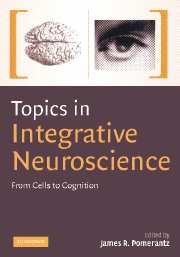Book contents
- Frontmatter
- Contents
- List of contributors
- Preface
- Overview of neuroscience, choice and responsibility
- 1 Neuroscience, choice and responsibility
- PART I HIGHER ORDER PERCEPTION
- PART II LANGUAGE
- PART III MEMORY SYSTEMS
- Introduction to Memory Section
- 9 Memory systems
- 10 A brain system for declarative memory
- 11 The role of the lateral nucleus of the amygdala in auditory fear conditioning
- 12 On crucial roles of hippocampal NMDA receptors in acquisition and recall of associative memory
- PART IV SENSORY PROCESSES
- Index
- Plate section
- References
10 - A brain system for declarative memory
Published online by Cambridge University Press: 08 August 2009
- Frontmatter
- Contents
- List of contributors
- Preface
- Overview of neuroscience, choice and responsibility
- 1 Neuroscience, choice and responsibility
- PART I HIGHER ORDER PERCEPTION
- PART II LANGUAGE
- PART III MEMORY SYSTEMS
- Introduction to Memory Section
- 9 Memory systems
- 10 A brain system for declarative memory
- 11 The role of the lateral nucleus of the amygdala in auditory fear conditioning
- 12 On crucial roles of hippocampal NMDA receptors in acquisition and recall of associative memory
- PART IV SENSORY PROCESSES
- Index
- Plate section
- References
Summary
Our understanding about the brain system that mediates memory began in the 1950s with the landmark case study of patient HM (Scoville & Milner, 1957). To relieve epilepsy that was intractable to pharmacological intervention, surgeons removed a large part of this patient's temporal lobes, including the amygdala, part of the hippocampus, and the cortex immediately surrounding the hippocampus and amygdala. Following surgery, HM exhibited a severe amnesia, leaving nonmemory aspects of intelligence and cognition intact. This observation demonstrated that memory could be separated from other cognitive functions and that structures of the medial temporal lobe are critical to memory.
While the early neuropsychological reports clearly pointed to the importance of the temporal lobes in memory, there was debate over precisely which temporal structures were important. Because the available clinical cases did not provide highly specific anatomical resolution, efforts were made to develop animal models in which experimental brain lesions could be performed with the necessary anatomical specificity. However, the early efforts to model amnesia in monkeys and rats did not yield a consistent pattern of severe and selective amnesia, precluding useful insights into the anatomical identification of the memory system. With hindsight, it is now clear that the difficulty in characterizing the brain system responsible for memory arose for two reasons (Eichenbaum et al., 2000). First, while the memory deficit following medial temporal damage was initially thought to be global in nature, it is now understood that damage to the medial temporal region causes amnesia that is limited to a specific domain of memory, and that other brain systems mediate other types of memory.
Information
- Type
- Chapter
- Information
- Topics in Integrative NeuroscienceFrom Cells to Cognition, pp. 265 - 298Publisher: Cambridge University PressPrint publication year: 2008
References
Accessibility standard: Unknown
Why this information is here
This section outlines the accessibility features of this content - including support for screen readers, full keyboard navigation and high-contrast display options. This may not be relevant for you.Accessibility Information
- 1
- Cited by
